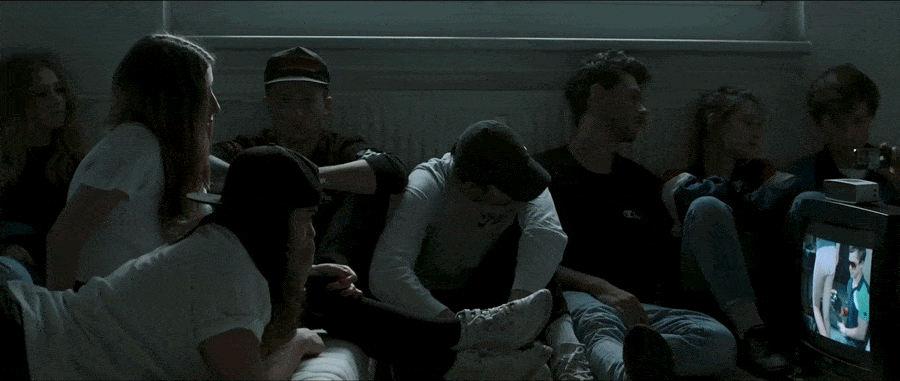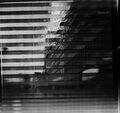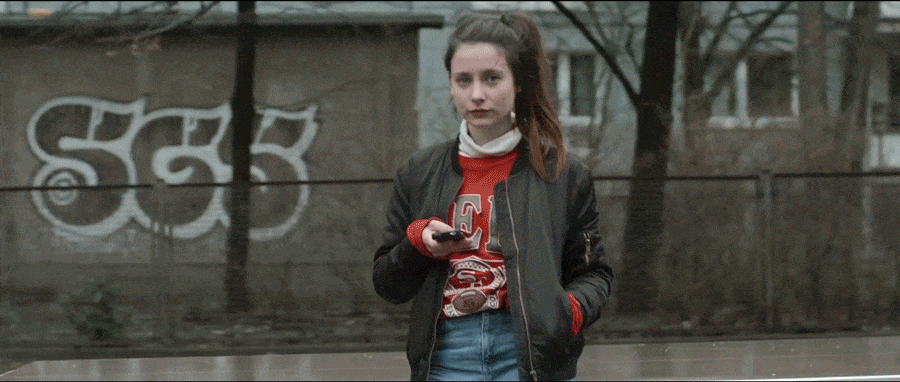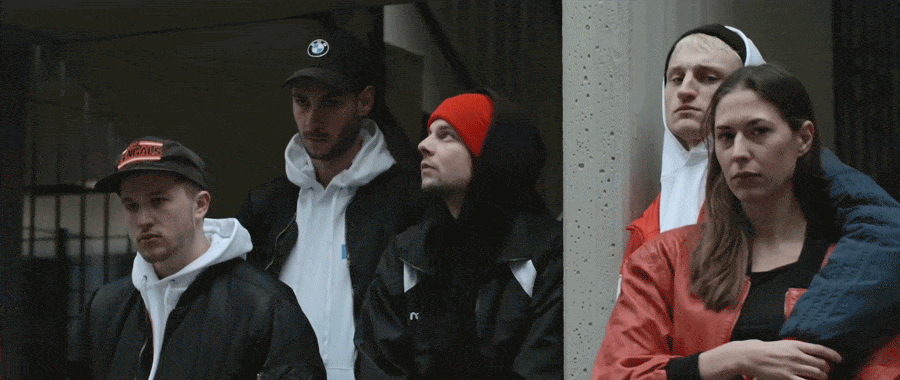Andreas Project Proposal Draft 4: Difference between revisions
| Line 45: | Line 45: | ||
<br />Them looking at a phone or television is very literal and direct. | <br />Them looking at a phone or television is very literal and direct. | ||
<br />I want them to hold a piece of wood that is being carved into its final shape. It would be the metaphor of brevity: taking away layer by layer until eventually the final shape is being reached. The creator/speaker/narrator defines what is necessary and what is redundant in communicating her or his message. | <br />I want them to hold a piece of wood that is being carved into its final shape. It would be the metaphor of brevity: taking away layer by layer until eventually the final shape is being reached. The creator/speaker/narrator defines what is necessary and what is redundant in communicating her or his message. | ||
By showing the scene as a GIF, it constantly repeats itself. This represents the trauma as a failure of representation. The notion of tension is showing the necessity of brevity. | |||
==What is your timetable?== | ==What is your timetable?== | ||
Revision as of 19:15, 4 December 2019
Introduction
Being a Millenial I grew up with classic news outlets on radio, newspapers and television as well with the rise of news outlet in online and on-demand channels. With the ability to share information freely online, it feels like polarization is increasing. The natural filter of finance (paying for each second of airtime) is obsolete. Even though this filter may not be perfect, but the scarcity of resources required publishers to consider what they are publishing. With these physical and financial filters gone, we are left at the mercy of algorithms and advertising deals that reward attention rather then education. The result is clickbait, publications being forced to vie for views.
I am interested, whether we are coping with an information overload, like Kenneth Goldsmith is claiming.
What do you want to make?
I want to produce a series of discreet works which explore brevity in the moving image.
In the moment of reception the moving image is similar to a monologue. Therefore the brevity discourse is very similar. Is there a way of finding the moderate oration, like Aristotle demanded it in his rhetorics? For Cicero the diffuseness, or the garrulity of a speech is a danger. After all the attention of the recipient shall not be lost. For Quintilian the shortness is a danger: instead of shortening everything at the cost of understandability, one shall rather bring up more content. Shortening would be a selection- and manipulation itself, according to Quintilian.
This exercise is trying to find the modest or appropriate amount of communication. It shall remove decoration and accessories or even add all these redundancies to find the essence. How is simplification or excess changing the visual appearance of content?
The thesis shall explore brevity on a didactic level, whereas my practice will give me the freedom to approach the topic artistically. Giving myself the space to make work that really explores the possibilities and implications of this term 'brevity'.
How do you plan to make it?
This project will be an ongoing interplay between Theory/Research and Practice.
Theory
After looking at the historical brevity discourse last year, I want to do research on how the brain processes information. How does distraction work? And is distraction necessarily a bad thing?
Furthermore I want to research density of information in news programs. How is modern media supporting or contradicting focus on its program? To which extent are news outlets made to process their information? Let's take the public-sector broadcaster ‘Das Erste’ for example: The day starts with five minutes national and international news (including the weather) at 09:00. This newsshow called ‘Tagesschau’ then is being broadcasted again from 12:00 to 12:15. At 14:00, 15:00 and 16:00 it provides another program for ten minutes. At 17:00 and 20:00 the Germans can watch news again for fifteen minutes. Eventually, at 22:15 ‘Tagesthemen’ is providing thirty minutes of news from the day (including weather). How come, that this sender thinks the television crowd is only capable of receiving ten to fifteen minutes of news throughout the day? Or is that already too much? Of course I am very aware that television is already outdated and society is much more moving to on-demand news media via Apps (on Mobile as well as on Desktop), but doesn't television have enough historical statistics to know how to reach their audience?
I want to find out to which extent brevity applies to the moving image in social media (including advertising). Instagram for example only allows Stories of max. 15 Seconds each or Videos of max. 1 Minute each. How is the content played out in comparison to other Social Media Outlets or Websites?
Practice
I tried putting together a film that combined interviews from professionals (in the field of psychology and sociology) and my observations (I am aware that these may be subjective and sometimes abstract) on the topic (Fig 1-3). But the imagery immediately lost clarity by layering it into a sketch that synthesized the various things I have been working on. Therefore I want to use this sketch as a basis to think of the scenarios I want to put my work in.
Therefore I rather want to work with metaphors involving my observations. I want the imagery to comment itself through the context.
Let's take this shot for example:

Them looking at a phone or television is very literal and direct.
I want them to hold a piece of wood that is being carved into its final shape. It would be the metaphor of brevity: taking away layer by layer until eventually the final shape is being reached. The creator/speaker/narrator defines what is necessary and what is redundant in communicating her or his message.
By showing the scene as a GIF, it constantly repeats itself. This represents the trauma as a failure of representation. The notion of tension is showing the necessity of brevity.
What is your timetable?
November
Film:
Sketch ideas on how to approach the film: what will be the content (metaphors) and how can it be shot
December
Film:
film testing, map out all technical details: get in contact with participants, begin production plans; work out screenplays; begin story-boarding;
Write the script and the shooting plan for the final film.
January
Thesis: first thesis draft complete by end of month
Film: all resources/people/support secured by month’s end, complete story-boarding, fix schedule with all individuals
February
Thesis: second draft
Film: set design etc., schedule for filming fix
March
Thesis: complete thesis
Film: Shoot first versions and get feedback from tutors and classmates (I am trying to do this even earlier, depending on the outcome of my early filming sessions)
Exhibition: how shall the various pieces of work be exhibited?
April
Film: editing and contingency for filming, if necessary shoot additional shots
Exhibition: work out communication-design supporting the work
May
Film: final editing and completion
Exhibition: exhibition layout plan
June
Final Assessment
Exhibition: printing/construction of any supporting work
July
Exhibition buildup
Why do you want to make it?
Whenever I have a discussion about history or politics, many of my friends are stating that they don't want to take part in the discussion because they feel like they know too little about it. I was observing this not only in the small circle that I used to live in, but I have heard this statement being made everywhere I have been so far. Reading Kenneth Goldsmiths Wasting Time on the Internet I am curious if this is really due to the fact that the modern society is exposed to much more information (Short Messages, E-Mails, Billboards, Radio, Newspages and so on).
I want to find out how a varying extent of content is changing the mediation of communication.
How much communication is necessary? And necessary for whom? For the sender, or the recipient? What defines, what is exceeding the needful, what is unnecessary or what is missing to the needful?
Who can help you and how?
Aside from the tutors who can help me with critical thinking and narrative skills developing, the PZI classmates can always offer excellent ideas for my work.
I will reach out for example to Dr. Maren Jäger (who is a Postdoctorate for Literature at the HU Berlin), Susanne Janssen (Graphic Design Graduate of the WdKA 2019), Florian Cramer (Reader in 21st Century Visual Culture/Autonomous Practices) and Kenneth Goldsmith (Poet, Writer and Teacher at the University of Pennsylvania) and see if they would be open to be interviewed for my work.
On top of that I will be able to borrow equipment from the photo-studio I am working at right now. Since the Academy is rather poorly equipped, this is a substantial help on getting cameras and lenses.
Relation to previous practice
The first Trimester I did experiments on the topic of maximisation and minimisation. With the Focal Camera I was examining the recognition of two subjects in one image (Fig 4.). I wanted to find out how the identity of one image changes bringing in two subjects in one. Secondly I did digital glitch experiments. In this way it was closely connected to the information theory. This exercise had a high entropy, describing the amount of uncertainty involved in the value of a random variable (Fig 5.). The outcome of the glitch was relatively unpredictable, but actually performing the glitch and learning the results gave some new information.
Afterwards Susanna Fasciolo and I made a photo series called Frown, depicting portraits of cyclists and people who ride their scooters over the Erasmusbridge (Fig 6.). The book consists of cropped images showing faces. We wanted to force the viewer to make assumptions on where these photos could have been taken.
Then I did the short film with the title The Gifted Horse for the screening at the EYE Amsterdam (Fig 7.). It is five minutes long, has 5.1 Surround Sound and is being screened in FullHD. In terms of film genre, it probably would fit best into the genre of the Drama. The visual style is low-key, black-and-white, sometimes also showing grain and light leaks that were very present during post-war cinema. The sujet is the portrait of an actress that is representing the German actress/singer Hildegard Knef. The short film links in some scenes to the cynicism usually present in film noir during the post-war realistic period. Since the actress is recalling her career from a modern perspective, the post-war era is being contrasted by using an aspect ratio of 16:9, which is representative for the nowadays cinematic context. The only sound throughout the film is a combination of slow-paced classical and ambient-electronic music. More specific, the film is accompanied by the song A Pledge, that was composed by the French musician Mike Lévy, professionally known as Gesaffelstein and was released in the year 2015. With its estimated 95bpm the track is comparably slow, leading the viewer unagitated through the story. The whole film was shot in 60fps and is played back in half-speed, slowing down all movements.
Relation to a larger context
This text has been taken from my Andreas methods 15-05-19
How concentrated is the reception of content happening nowadays? Short messages, eMail, Chats and Twitter – these and other mass-media did bring up a mode of correspondence, that is setting the virtus dicendi because of time- and type economy. Emoticons and the more or less creative abbreviation culture (from fyi, to btw) are some symptoms of this maxime. Kenneth Goldsmith is setting up an interesting hypothesis: he is claiming, that people do not read less in overall, but the omnipresence of digital media is causing the opposite. He is stating that daily news, Facebook statuses or the fast Twitter notification on the smartphones are making everyone read more, like no print medium would have been able to. That is why the amount of reading would have even increased; only the way of reading has changed. (Goldsmith, 2016, p. 4)
In the meantime even carriers of important positions are using just 140 characters to send out information of big scope. Donald Trump was therefore even called the master of simplification. Are these messages therefore more authentic? Closer to the person? Or does it instead just reveal a polarization, that has been less visible before? By using short statements one can react often and quick. But quantity has the tendency to cover quality. (Jäger, 2018)
References
COUPLAND, D. (1991) Generation X: Tales for an Accelerated Culture. 1st ed. New York: St. Martin's Press
EAMES, C. and R. (1953) A Communications Primer [online]. Available at: https://archive.org/details/communications_primer (Accessed: 23 May 2019)
FLUSSER, V. (2000) Towards a philosophy of photography. 1st ed. London: Reaktion Books
GOLDSMITH, K. (2016) Wasting Time on the Internet. 1st ed. New York: HarperCollinsPublishers
JANSSEN, S. (2019) Software organism BA Research Project [online]. Available at: http://www.susannejanssen.eu/software-organism-ba-research (Accessed: 07 October 2019)
JÄGER, M. (2018) Kommunikation in der Wissenschaft Kurz und knackig, auf die Zwölf, bitte. Deutschlandfunk Nova [online]. Available at: https://www.deutschlandfunknova.de/beitrag/kommunikation-in-der-wissenschaft-kurz-und-knackig (Accessed: 27. February 2019)
ROSA, H. (2016) Beschleunigung und Entfremdung: Entwurf einer kritischen Theorie spätmoderner Zeitlichkeit. 5. Auflage. – Berlin : Suhrkamp
Sketches
Visual Inspiration:
Metahaven – The Sprawl
The project explores the mutation of propaganda in the age of social media, with a particular focus on how the diffuse, networked circulation of messages through these channels affects how we read, interpret, and understand events.
Quote from http://sprawl.space/about-the-sprawl/ Nowadays, films live in a thousand and one forms on the internet. As short trailers, fragments, cloud-based copies of copies, endangered data, self-hosted vaults, and so on. Viewing cinema on a laptop screen is only possible when remembering that such an experience has little to do with cinema itself. As a hybrid, episodic documentary, “The Sprawl”‘s story isn’t linear. The film lends itself to be seen as a succession of impressions—a trailer, forever unfinished; the duration of each of those video pieces, or “shards,” is attuned to an attention span that is less cinema, and more internet.
http://www.youtube.com/watch?v=knk74TJgT5E
http://www.youtube.com/watch?v=zay2MW_iIuY
http://www.youtube.com/watch?v=5x0NRIJWWOs
I find it inspiring to read what Metahaven have to say on their treatment of temporality of the film Sprawl:
https://prostory.net.ua/en/9-publikatsii/krytyka/300-imaginary-motherland-some-notes-on-the-sprawl-propaganda-about-propaganda-and-a-google-doc-conversation-with-metahaven released 2018 by prostory.net.ua
Lesia Prokopenko interviewing Methaven LP: ‘Technology, that is, the internet, has been changing our relations with language and information similar to how the invention of printing changed them, and, later, the invention of photography — and this inevitably implies transformations in the perception of time. Film, as a medium, is one of the ways to explore and manipulate time, which is, at the moment, a more appealing idea than ever. How do you treat temporality in your work?’
MH: ‘(...) In our films, including Information Skies, but also in our new essay, Digital Tarkovsky—which is to be out soon with Strelka Press—we address duration or temporality. Andrei Tarkovsky and Aleksandr Sokurov are heroes of ours who used, and use, time as their primary instrument. But we want to look at this through the lens of platforms, and in the digital age (sorry for the term), where duration is associated with Facebook, Instagram addiction, and Netflix binge-watching. We are convinced that there is a cinematic core to our time spent on the smartphone—if only because it is banned from most movie theatres.’
Back to Main Project Seminar:
http://pzwiki.wdka.nl/mw-mediadesign/index.php?title=Graduate_Seminar_2019-2020









